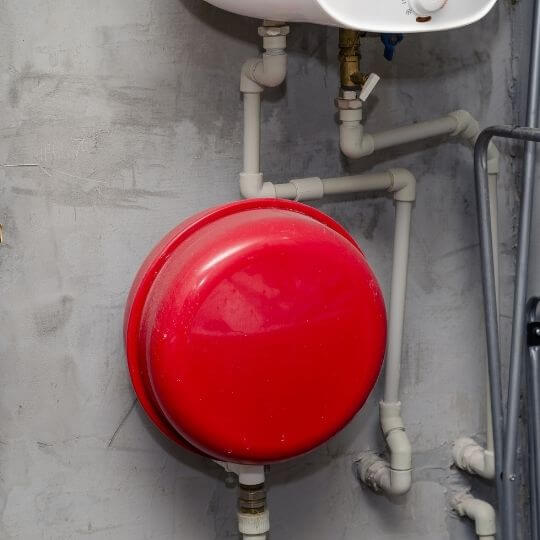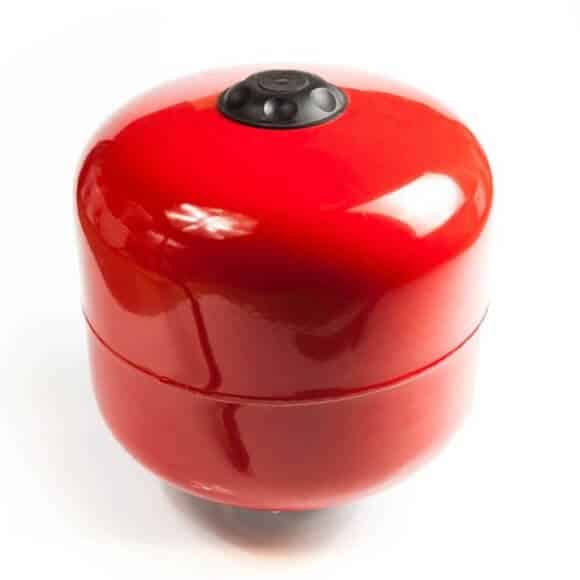With all the numerous jargon, tools, and technologies, the world of plumbing can be confusing. For instance, the choice of an expansion tank vs pressure tank is very perplexing for homeowners. Although they share common features, expansion and pressure tanks have very different applications. So what are the differences between them, and which one should you choose for your system?
The most significant distinction between pressure tanks and expansion tanks is their intended application. Expansion tanks are built above a water heater to protect it from hot water expansion. Pressure tanks are placed near your well pump to safeguard it and help it last longer.
Despite their similarities, these plumbing components are not interchangeable. We’ll take a closer look at both expansion and pressure tanks in this article. We’ll also assist you in determining which one, if any, or both, you require.
Purpose of an Expansion Tank

Expansion tanks reduce the high water pressure caused by hot water. When water is heated, it expands, causing the pressure inside the water heater to rise. That excess pressure has to go somewhere. This is where the expansion tank comes in [1].
Whether or not you require an expansion tank is mainly determined by the configuration of your plumbing system. For example, the excess water pressure would pass through your water pipes and into the city water supply in the past because plumbing systems were set up as “open-loop” systems. On the other hand, most new communities have begun to install check valves in their water systems.
After water enters the residential supply system, the check valve effectively blocks and prevents it from flowing back into the city water supply. This implies that the pressure caused by hot water expansion is trapped in your water heater and the pipes around it.
The consequences of not having an expansion tank
If you fail to install an expansion tank on a closed loop water system, the following are potential consequences.
- Water heater lifespan will be reduced: Your water heater is the first component to be damaged by water expansion. This happens to water heaters that don’t have an expansion tank above them. Because of the excess pressure, the sides and tops of the tank expand outward and eventually burst out.
- The pressure relief valve will be damaged: If your water heater isn’t damaged, your pressure relief valve will most likely be. When the pressure in the water heater rises too high, the pressure relief valve opens and relieves it. However, the valve may fail and be destroyed under excessive pressure.
- Valves on your other appliances will be destroyed: Solenoid valves are fitted in each of your toilets and washing machines. If the pressure in your plumbing system becomes too high, it’s possible that these valves could be destroyed, thereby interfering with the flow of water in and out of these fixtures.
Purpose of a Pressure Tank
Pressure tanks can safeguard and extend a pump’s life by lowering the number of cycles the pump needs to go through [2]. Reducing the number of cycles helps the pump last longer by requiring it to operate less times.
In addition, when the pump is not in use, pressure tanks store water that can then be distributed throughout your home. This also minimizes the number of pump cycles.
Your well pump may not be able to keep up with your home’s water consumption at times. This is where the water stored in the pressure tank helps. It can be used to meet the water demand when the pump is overwhelmed, especially for large households.
Overall, the pressure tank is critical for pumps because it limits the number of cycles a pump has to run, thereby minimizing maintenance.
Therefore, both the pressure and expansion tanks are designed to safeguard specific elements of your plumbing system. The water heater, pressure relief valves, and solenoid valves on your appliances are all protected by expansion tanks.
In addition, the pump, which is one of the most expensive components in your plumbing system, is protected and extended by pressure tanks.
Expansion Tank vs Pressure Tank

The most critical distinction between expansion and pressure tanks is their purpose. The expansion tank handles water expansion and also protects water valves and heaters.
On the other hand, the pressure tank extends the pump’s life. Although the entry-level prices for both tanks are similar, they differ in terms of function, cost and durability.
Expansion Tank vs Pressure Tank Main Differences
Below are outlined the main differences in expansion tank vs pressure tank in the three categories.
1. Functionality
It is critical to understand the operation of the two types of tanks. Otherwise, it’s much easier to make a poor decision that won’t help you. Both of these tanks keep pressure in check and protect against injury.
First, we’ll look at expansion tanks. As the name implies, an expansion tank aids in the thermal expansion of water. Water heaters are commonly linked to these tanks. Have you ever used a kettle to boil water? Water expands as steam when it is heated. A closed water system, however, does not have a mechanism to handle the extra pressure caused by the expanding water.
Over time, this wears down the valves and heaters. As a result, it has the potential to cause water system leakage. This is where the expansion tank becomes handy. It has a bladder in the center that helps to keep the pressure constant. As a result, when there is a lot of pressure, the extra water from the heater is stored in the expansion tank.
When the pressure returns to normal, the compressed air in the tank will push the water back into the system. So your valves, heater, and supply line will all be safe.
On the other hand, pressure tanks are linked to the water pump. When there is a pressure drop in the system, the pump is expected to start up. However, if the pump keeps starting and stopping whenever there’s water shortage, it may end up experiencing premature wear and tear.
The same pressure principle that works for the expansion tank works here as well. The pressure tank is always loaded with water. When the system pressure drops, water in tank flows out to supply the deficit before the pump kicks in again.
This reduces the frequency with which the water pump has to operate. Instead, it works less and distributes water more effectively. This ensures the safety of your water pump. Although the pressure tank might become clogged at times, repairing it is less complicated than repairing the water pump.
2. Durability
Durability is always desirable in water tanks because they are heavily used. An expansion tank’s average lifespan is between 5 and 10 years. Therefore, they are incredibly durable and can keep your system in tip-top shape for a long time. A pressure tank, on the other hand, lasts less than its expansion tank counterpart. Most pressure tanks will easily survive 5 to 7 years before they need to be replaced.
3. Cost implications
The price of a component has a significant impact on decision-making. This applies to water tanks as well. The entry price for both of these tanks is comparable. Those with additional features, however, are more expensive. The cost is determined by the capacity and pressure handled by the tank. The cost of an expansion tank typically ranges from $40 to $200 for entry level domestic systems. Nonetheless, expansion tanks costing between $100 and $150 will give you everything you need.
The pressure tank, on the other hand, can be pretty costly. The cost typically ranges from $50 to $600. However, a commercial pressure tank might cost up to $1500. To meet demand, most residential properties rely on larger pressure tanks. A standard pressure tank should suffice in all other cases.
Although you can virtually choose and install whatever tank you desire, your budget and system specifications will influence what you go for. The cost of installing the two tanks differs depending on their sizes and complexities. However, installing a home expansion tank is usually less complicated than a pressure tank. This is because pressure tanks need to be installed and serviced by an expert [5].
Can a pressure tank be used as an expansion tank?

Despite their similar characteristics and appearances, pressure and expansion tanks do not perform the same function. Expansion tanks serve water heaters while pumps benefit from pressure tanks.
You don’t always require an expansion tank if you have an open-loop plumbing system. However, building codes may require expansion tanks depending on where you reside, particularly if you have a closed-loop system. Pressure tanks aren’t always necessary, although they’re becoming more common in recent homes. Pressure tanks help your well pump work better and last longer, crucial to your plumbing system.
Will an Expansion Tank Increase Water Pressure?
A sudden increase in water pressure is something that many people are concerned about while using pressure tanks. On the other hand, expansion tanks are intended to handle the extra pressure that hot water generates
At first, the expansion tank is filled with air. Then, as the hot water in the heater expands, it is pushed into the expansion tank, which then gets a mixture of air and water. The air compresses when water replaces it, allowing for a comparatively little rise in water pressure.
Expansion tank alternatives
There may be another solution for you if you don’t want to deal with the inconvenience and expense of installing an expansion tank. Thermal expansion relief valves are quickly replacing expansion tanks as a preferred choice [6]. Pinhole leakage, condensation concerns, and expensive installation are common problems with expansion tanks.
Thermal expansion relief valves are less expensive to install, have fewer moving parts, and require less maintenance. Rather than retaining excess pressure inside a tank, relief valves open and discharge it into the atmosphere. Be careful to verify your local building codes to see if relief valves are a possibility rather than an expansion tank.
Final Thoughts
There is a great deal of confusion as far as the expansion tank vs pressure tank debate is concerned. Pressure tanks and expansion tanks perform a critical purpose within your plumbing system.
Pressure tanks should be put on all piping systems to safeguard and maintain your well pump. Expansion tanks aren’t always required, but they can save you hundreds of dollars in repairs and damage. If you believe you need one or both of these tanks, you should consult a plumber.

Michael Davis is a heating & plumbing expert who currently works as independent contractor in SC. He also writes for Plumbertip.
For almost 10 years he worked on various plumbing tasks across South Carolina.



